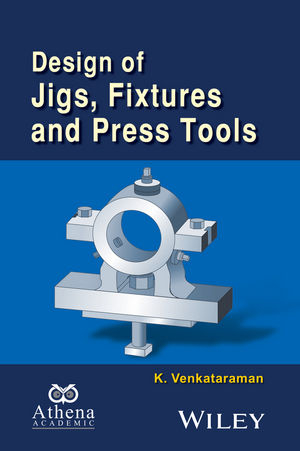
Design of Jigs, Fixtures and Press Tools
Wiley-Blackwell (an imprint of John Wiley & Sons Ltd) (Verlag)
978-1-119-15567-6 (ISBN)
- Titel ist leider vergriffen;
keine Neuauflage - Artikel merken
K Venkataraman obtained his Engineering (Mechanical) degree from College of Engineering, Guindy (presently Anna University), Chennai, India, and post-graduation from Concordia University, Canada. He joined Durgapur Steel Plant of SAIL in 1971 and later worked with engineering consultancy MECON for nearly 30 years. After leaving MECON in 2000, he joined as a senior faculty in Sathyabama Institute of Science and Technology, Chennai and later moved to the Mechanical Engineering department of Anna University. He is a member of the Institution of Engineers (India) and American Society of Mechanical Engineers.
Preface vii Foreword ix PART I : JIGS, FIXTURES 1. Introduction to Jigs and Fixtures 1.3 1.7 1.1 Introduction to Modern Day Production 1.3 1.2 Definition of Jigs, Fixtures and Tooling 1.4 1.3 Fundamental Concepts in the Design of Jigs and Fixtures 1.6 Summary 1.7 Review Questions 1.7 2. Design of Locators 2.1 2.9 2.1 General Principles of Degrees of Freedom and Constraints 2.1 2.2 Foolproofing 2.3 2.3 Other Principles in the Design of Locators 2.3 2.4 Various Types of Locators 2.4 Summary 2.9 Review Questions 2.9 3. Design of Clamps 3.1 3.12 3.1 Principles of Clamping 3.1 3.2 Classification of Clamps 3.2 Summary 3.11 Review Questions 3.11 4. Drilling Jigs 4.1 4.12 4.1 Introduction 4.1 4.2 Types of Jigs 4.1 4.3 Components of Jig 4.4 Summary 4.11 Review Questions 4.11 5. Design of Milling Fixtures 5.1 5.8 5.1 Salient Features of Milling Fixtures 5.1 5.2 Classification of Milling Fixtures 5.2 Summary 5.7 Review Questions 5.7 Annexure 5.7 6. Other Types of Fixtures 6.1 6.18 6.1 Turning, Grinding, Broaching, Welding and Modular Fixtures 6.1 6.2 Turning Fixtures 6.1 6.3 Grinding Fixtures 6.3 6.4 Broaching Fixtures 6.5 6.5 Welding Fixtures 6.6 6.6 Modular Fixtures 6.6 6.7 Advantages and Disadvantages of Modular Fixtures 6.9 Summary 6.10 Review Questions 6.10 Annexure-I 6.11 Annexure-II 6.13 Worked Examples for Jigs and Fixtures WE.1 WE.7 WE 1. Inclined Drilling Jig with Indexing (Chapter 4) WE.1 WE 2. Box Jig (Chapter 4) WE.2 WE 3. Indexing Milling Fixture (Chapter 5) WE.4 WE 4. String Milling Fixture (Chapter 5) WE.5 WE 5. External Broaching Fixture (Chapter 6) WE.5 WE 6. Boring Fixture (Chapter 6) WE.7 Appendix A: Metal Cutting Tools A.1 A13 A.1 Introduction A.1 A.2 Single-Point Cutting Tools Used in Turning and Boring Fixtures A.1 A.3 Multi-point Cutting Tools A.4 Appendix B: Fits and Tolerances B.1 B.7 B.1 Introduction B.1 B.2 Unilateral and Bilateral Tolerances B.1 B.3 Shaft and Hole Basis of Specifying Tolerances B.2 Summary B.7 Appendix C: Suggested Questions and Answers C.1 C.8 PART II: PRESS TOOLS 1. Introduction to Presses and Auxiliary Equipment 1.1 1.9 1.1 Classification of Presses 1.3 1.2 Classification Based on Power Source 1.3 1.3 Classification Based on Type of Press Frame 1.5 1.4 Classification Based on Method of Actuation of Slide 1.6 1.5 Classification Based on the Number of Slides in Action 1.8 Summary 1.9 Review Questions 1.9 2. Sheet Metal Forming Processes 2.1 2.20 2.1 Classification 2.1 2.2 Calculation of Force Requirements in Blanking and Piercing 2.6 2.3 Die Clearances in Blanking and Piercing 2.7 2.4 Process of Bending through V Die and Wiping Die 2.8 2.5 Forming Dies 2.12 2.6 Drawing Dies 2.16 2.7 Drawing of Box-like Shells 2.18 2.8 Direct and Reverse Redrawing 2.18 Summary 2.19 Review Questions 2.20 3. Introduction to Press Tools 3.1 3.14 3.1 Standard Die Set 3.1 3.2 Description of Press Tools 3.3 Summary 3.13 Review Questions 3.14 4. Introduction to the Design of Blanking, Piercing, Progressive and Compound Dies 4.1 4.22 4.1 Design of Blanking, Piercing, Progressive and Compound Dies 4.1 4.2 Guidelines for the Design of Press Tools 4.1 4.3 Design of Progressive Dies 4.6 4.4 Compound Die 4.13 4.5 Calculation of Centre of Pressure in Unsymmetrically Profiled Components 4.14 Summary 4.16 Review Questions 4.17 Annexure 4.17 5. Bending, Drawing and Forming Dies 5.1 5.23 5.1 Introduction 5.1 5.2 Classification of Bending and Other Forming Dies 5.1 Summary 5.20 Review Questions 5.21 Annexure 5.21 Design Exercises for Press Tools DE.1 DE.3 Appendix A: Properties of Materials A.1 A.4 Appendix B: Drawing Speeds and Lubricants B.1 B.3 Appendix C: Press Tools Suggested Questions and Answers C.1 C.10 Index I.1 I.11 References 1
| Reihe/Serie | ANE Books |
|---|---|
| Verlagsort | Chichester |
| Sprache | englisch |
| Maße | 180 x 254 mm |
| Gewicht | 592 g |
| Themenwelt | Technik ► Maschinenbau |
| ISBN-10 | 1-119-15567-3 / 1119155673 |
| ISBN-13 | 978-1-119-15567-6 / 9781119155676 |
| Zustand | Neuware |
| Haben Sie eine Frage zum Produkt? |
aus dem Bereich


